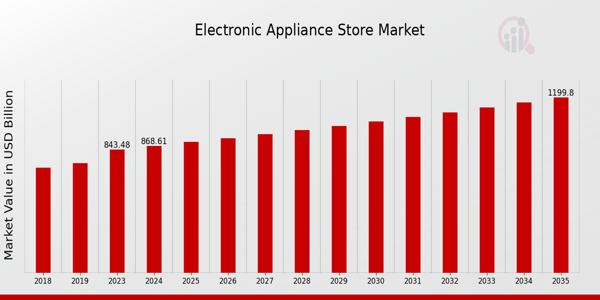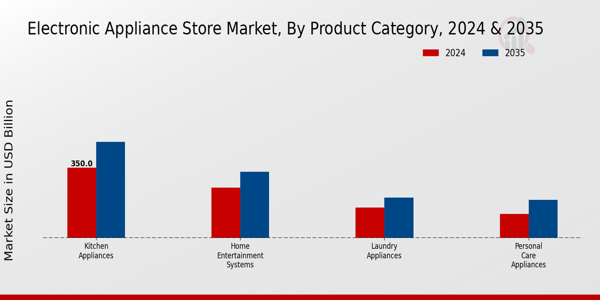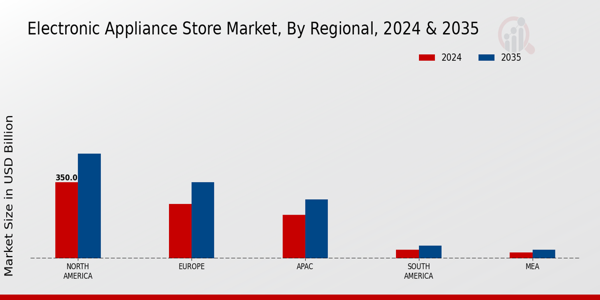Electronic Appliance Store Market Overview
As per MRFR analysis, the Electronic Appliance Store Market Size was estimated at 843.48 (USD Billion) in 2023.
The Electronic Appliance Store Market Industry is expected to grow from 868.61(USD Billion) in 2024 to 1,200.0 (USD Billion) by 2035. The Electronic Appliance Store Market CAGR (growth rate) is expected to be around 2.98% during the forecast period (2025 - 2035).
Key Electronic Appliance Store Market Trends Highlighted
Several key factors drive the Global Electronic Appliance Store Market. The emergence of new products, for instance, household gadgets like smart devices and appliances that consume less power, compel buyers who need convenience and sustainability. Increasing population purchasing power and urbanization also enable more people to purchase electronic appliances. Additionally, the shift towards more online shopping has changed how customers buy products, leading to higher consumption of electronics and other products purchased via the internet. This approach helps retailers reach wider consumer bases and serve them better.
There are significant opportunities to be explored within this market. The rise of eco-friendly products creates a niche for businesses that prioritize sustainability. Additionally, the integration of IoT technology in appliances offers a pathway for companies to innovate their product lines and enhance customer engagement. Market players can also benefit from targeting emerging markets where the demand for electronic appliances is steadily increasing. Collaborations with tech firms could provide new avenues for developing advanced features in products, further appealing to tech-savvy consumers. Recent trends indicate a growing preference for smart appliances that feature connectivity and automation.Consumers want appliances that not only perform tasks but also integrate seamlessly into their smart homes. The focus has shifted towards multifunctional devices that save space and enhance user experience. Moreover, there is an increasing inclination towards personalized customer service, as consumers seek tailored experiences both online and offline. Sustainability has also caught the attention of consumers, leading to a rising demand for energy-efficient and environmentally friendly appliances. These trends signify a market that is evolving rapidly to meet the changing preferences and values of consumers.

Source: Primary Research, Secondary Research, MRFR Database and Analyst Review
Electronic Appliance Store Market Drivers
Technological Advancements in Electronics
The Global Electronic Appliance Store Market Industry is witnessing remarkable growth driven by rapid technological advancements in electronics. Innovative features such as smart home technology, artificial intelligence integration, and IoT enhancements are reshaping consumer expectations and behaviors. These advancements are not just making electronic appliances more functional but also more energy-efficient and user-friendly. Consumers are increasingly drawn to appliances that offer seamless connectivity with other smart home devices, allowing for greater control and customization of their daily environments.Furthermore, manufacturers are consistently upgrading their products to maintain competitive advantage, leading to a continuous influx of cutting-edge appliances into the market. As the technological landscape evolves, so does consumer appreciation for sophisticated features, spurring demand in the Global Electronic Appliance Store Market Industry. The inclination towards newer technologies demands that manufacturers keep pace with developments, creating a symbiotic relationship between advancements in technology and market growth.Such trends emphasize the pivotal role of innovation in attracting consumers, whether they're first-time buyers or looking to replace older models. This landscape of constant change is not only driving sales growth but also expanding the market to new demographics and regions as electronic appliances become more accessible and relevant to a wider audience.
Growing Consumer Disposable Income
A crucial driver for the Global Electronic Appliance Store Market Industry is the increasing disposable income of consumers. As economies continue to grow and personal income levels rise, consumers are more willing to invest in high-quality electronic appliances. This trend is particularly marked in developing regions where rising affluence is leading to a consumer shift from basic to premium products. Shoppers are now seeking robust and sophisticated appliances that promise longevity and enhanced performance.The willingness to spend more is also being fueled by enticing financing options, making it easier for consumers to upgrade their existing appliances. As a result, retailers and manufacturers are focusing on developing product lines that meet the evolving needs of a wealthier clientele, ultimately translating to sustained market growth.
Rise in Home Renovation and Remodeling Activities
The rise in home renovation and remodeling activities is significantly driving the Global Electronic Appliance Store Market Industry. As homeowners invest in improving their living spaces, there is a concurrent increase in the demand for modern appliances that complement renovated homes. This trend is particularly evident in urban areas, where space optimization is critical, prompting consumers to seek compact yet advanced appliances. Renovation projects often involve the upgrade of kitchen and laundry appliances as homeowners aim to enhance both aesthetics and functionality.Consequently, retailers are witnessing a boost in demand, with more consumers looking for updated and stylish appliances to match their refreshed homes.
Electronic Appliance Store Market Segment Insights:
Electronic Appliance Store Market Product Category Insights
The Global Electronic Appliance Store Market has shown remarkable growth, particularly across various product category segments. The market was valued at 868.61 USD Billion by 2024 and steadily grew, reaching 1200.0 USD Billion by 2035. Within the Global Electronic Appliance Store Market, the kitchen appliances segment holds a significant majority, valued at 350.0 USD Billion by 2024, showcasing a pivotal role in the market due to the increasing home cooking trends and a shift towards energy-efficient appliances. The home entertainment systems segment is also notable, with a valuation of 250.0 USD Billion in 2024.The enduring demand for enhanced audio-visual experiences, particularly with the rise of smart technologies and streaming services, underscores its importance in the Global Electronic Appliance Store Market. Laundry appliances, valued at 150.0 USD Billion, represent another critical aspect, reflecting consumer preferences for convenience and efficiency in household chores, while personal care appliances, although smaller at 118.61 USD Billion in 2024, are experiencing growing consumer interest as personal grooming and wellness trends rise. Each of these segments contributes uniquely to the overall market dynamics, influenced by technological advancements and evolving lifestyle preferences.
The Global Electronic Appliance Store Market shows a clear segmentation, where kitchen appliances dominate the landscape due to their essential role in daily life; home entertainment systems follow closely as entertainment habits evolve, while laundry appliances sustain a steady demand. Personal care appliances, while less dominant, reflect a significant increase as self-care continues to rise in consumer priorities. Overall, the data indicates a versatile and dynamic market landscape where each product category plays a critical role in shaping consumer behavior and preferences.The Global Electronic Appliance Store Market statistics reflect this comprehensive segmentation, where innovation, trends, and changing consumer needs guide future growth trajectories across all product categories, leading to a vibrant, competitive landscape. The growth trends in these segments highlight the opportunities present in the Global Electronic Appliance Store Market, driven by consumer demands for smarter, more efficient, and convenient solutions to their everyday activities. This not only emphasizes the importance of understanding consumer behavior but also reinforces the potential for innovation and growth opportunities within the market.

Source: Primary Research, Secondary Research, MRFR Database and Analyst Review
Electronic Appliance Store Market Distribution Channel Insights
The Global Electronic Appliance Store Market revenue from Distribution Channels is projected to evolve significantly, with the overall market valued at 868.61 billion USD in 2024 and expected to reach 1,200.0 billion USD by 2035. The market growth is fueled by changing consumer behaviors and increasing reliance on technology. Online Retail is crucial as it contributes to the convenience and accessibility of electronic appliance shopping, thus drawing a substantial portion of consumers who prefer the digital shopping experience. Brick-and-mortar stores continue to hold importance for customers who value in-person experiences and instant product availability, often enhancing customer trust through direct interaction.Multi-channel retailers play a significant role by combining the strengths of both online and physical stores, allowing seamless shopping experiences that cater to various preferences. The Global Electronic Appliance Store Market segmentation reveals a balance among these channels, each contributing uniquely to market dynamics, highlighting trends of digital transformation and the adaptability of retailers in response to evolving customer demands. The competition among these distribution channels presents opportunities for innovation and improved customer satisfaction in the ever-evolving market landscape.
Electronic Appliance Store Market End User Insights
The Global Electronic Appliance Store Market reached a valuation of 868.61 USD Billion by 2024, reflecting the increasing demand across various consumer bases. The End User segment is critical in shaping the growth of this market, encompassing diverse categories such as Residential, Commercial, and Institutional. The Residential sector is paramount, as it accounts for a substantial proportion of the market, driven by innovations in smart home appliances and energy-efficient technologies that enhance consumer convenience and lifestyle.The Commercial segment plays a significant role as well, with the need for modern electronic solutions in businesses and retail environments promoting operational efficiency and customer service. Meanwhile, Institutional end users, including schools and healthcare facilities, have been increasingly adopting electronic appliances to improve functionality and experience. This diverse segmentation highlights the broad appeal and necessity of electronic appliances across multiple domains, making it a robust sector within the Global Electronic Appliance Store Market revenue landscape.With a keen focus on growing trends, opportunities, and challenges within these varied user categories, the market continues to evolve, reflecting ongoing consumer needs and technological advancements.
Electronic Appliance Store Market Smart Technology Adoption Insights
The Smart Technology Adoption segment of the Global Electronic Appliance Store Market is witnessing notable growth as consumers increasingly seek innovative solutions for their homes. By 2024, the market reached a valuation of 868.61 USD Billion, reflecting a strong interest in integrating technology into everyday appliances that enhance convenience and efficiency. Smart appliances, which have gained a significant foothold in this market, offer advanced features that cater to modern consumer needs, promoting energy savings and ease of use.Traditional appliances, while still holding a considerable market share, face competition from these tech-forward products as consumers shift towards automation and connectivity. The demand for smart devices is driven by trends in smart home technology and sustainability, with a focus on reducing energy consumption. However, challenges such as the integration of technology into existing infrastructure and the higher cost of smart products may impact growth. Despite these challenges, opportunities are abundant as manufacturers innovate and expand their product offerings, contributing to the overall development of the Global Electronic Appliance Store Market.Market growth in this segment is expected to transform how consumers interact with their domestic environments, making it a crucial area of focus for industry stakeholders.
Electronic Appliance Store Market Regional Insights
The Global Electronic Appliance Store Market demonstrates notable regional variations, with North America leading the market in 2024 at a valuation of 350.0 USD Billion, reflecting its significant consumer base and technology adoption rates. Europe follows closely, valued at 250.0 USD Billion, supported by innovation and robust market demand. The Asia-Pacific (APAC) region has a valuation of 200.0 USD Billion in 2024, highlighting its growing consumer electronics sector, driven by urbanization and increasing disposable incomes. South America is acknowledged for its developing market, valued at 40.0 USD Billion, and the Middle East and Africa (MEA) at 28.61 USD Billion, indicating less dominance but growth opportunities fueled by rising consumer spending.These regions' valuations emphasize their strategic importance within the Global Electronic Appliance Store Market. North America and Europe dominate the market due to established infrastructures and consumer familiarity with electronic appliances, while APAC showcases significant growth potential driven by demographic trends and technological advancements. Overall, the Global Electronic Appliance Store Market segmentation reveals a diversified landscape with distinct growth drivers influencing each region's dynamics.

Source: Primary Research, Secondary Research, MRFR Database and Analyst Review
Electronic Appliance Store Market Key Players and Competitive Insights:
The Global Electronic Appliance Store Market is a dynamic and competitive landscape characterized by diverse players vying for consumer attention and loyalty. This market segment encompasses a wide range of products, including household electronics, kitchen appliances, and personal gadgets, all of which cater to ever-evolving consumer preferences and technological advancements. As shoppers increasingly seek convenience, quality, and innovation, electronic appliance stores are adapting their strategies to remain relevant in a crowded marketplace. Key competition arises not only from brick-and-mortar stores but also from online retail giants, creating a pressure cooker environment where businesses must consistently enhance their offerings and customer service.Fnac Darty stands out in the Global Electronic Appliance Store Market with a formidable presence and a strong reputation for delivering quality products and exceptional customer experience.
The company's extensive network of physical stores enables consumers to engage with products directly, fostering trust and satisfaction. Moreover, Fnac Darty has successfully integrated an omnichannel approach that combines their online platforms with in-store experiences, allowing customers to enjoy seamless shopping opportunities. This adaptability has solidified Fnac Darty's position as a leader in providing not just a wide variety of products but also personalized services that cater to a diverse customer base. Their commitment to after-sales support, knowledgeable staff, and a robust range of offerings in electronics give them a distinct advantage in this competitive landscape.On the other hand, Target presents a unique and relevant competitor within the Global Electronic Appliance Store Market, utilizing its well-known brand equity to attract a broad spectrum of customers.
The retailer's approach strategically intertwines everyday essentials with a curated selection of electronic appliances, making it a go-to destination for consumers seeking convenience and affordability. Target is renowned for its aggressive pricing strategies, promotional offers, and loyalty programs, which resonate well with budget-conscious shoppers. The retailer's investments in digital transformation have enhanced its online presence, enabling smooth online ordering and efficient in-store pickup, thereby streamlining the shopping experience. Through a mix of exclusive partnerships and collaborations, Target continues to enrich its product portfolio, positioning itself effectively within the competitive realm of electronic appliance sales.
Key Companies in the Electronic Appliance Store Market Include
- Fnac Darty
- Target
- Amazon
- Home Depot
- Alibaba
- Walmart
- Costco
- Sears
- Argos
- Metro AG
- John Lewis
- Carrefour
- Lowe's
- MediaMarkt
- Best Buy
Electronic Appliance Store Market Industry Developments
Recent developments in the Global Electronic Appliance Store Market showcase considerable activity among major players. Fnac Darty has been enhancing its product offerings and expanding its online presence to capture a larger share of the market, while Target is focusing on diversifying its electronic product range to attract tech-savvy customers. Amazon continues to innovate with its smart home products, further solidifying its position in the market. Home Depot is investing in home improvement appliances, aligning with growing customer preferences for efficiency and sustainability. Companies like Walmart and Costco are enhancing their supply chain logistics to expedite delivery times, which has become increasingly essential in the current retail landscape. Notably, Best Buy has been working on partnerships to provide more exclusive products, aiming to strengthen customer loyalty. Recent news included the potential acquisition discussions involving Argos and Metro AG, which may reshape competitive dynamics in the sector. As growth in market valuation reflects the increasing consumer demand for electronic appliances, companies are examining strategic collaborations and investments that can further drive their expansion in a highly competitive environment.
Electronic Appliance Store Market Segmentation Insights
Electronic Appliance Store Market Product Category Outlook
- Kitchen Appliances
- Home Entertainment Systems
- Laundry Appliances
- Personal Care Appliances
Electronic Appliance Store Market Distribution Channel Outlook
- Online Retail
- Brick-and-Mortar Stores
- Multi-Channel Retailers
Electronic Appliance Store Market End User Outlook
- Residential
- Commercial
- Institutional
Electronic Appliance Store Market Smart Technology Adoption Outlook
- Smart Appliances
- Traditional Appliances
Electronic Appliance Store Market Regional Outlook
- North America
- Europe
- South America
- Asia-Pacific
- Middle East and Africa
| Attribute/Metric Source: |
Details |
| MARKET SIZE 2023 |
843.48(USD Billion) |
| MARKET SIZE 2024 |
868.61(USD Billion) |
| MARKET SIZE 2035 |
1200.0(USD Billion) |
| COMPOUND ANNUAL GROWTH RATE (CAGR) |
2.98% (2025 - 2035) |
| REPORT COVERAGE |
Revenue Forecast, Competitive Landscape, Growth Factors, and Trends |
| BASE YEAR |
2024 |
| MARKET FORECAST PERIOD |
2025 - 2035 |
| HISTORICAL DATA |
2019 - 2024 |
| MARKET FORECAST UNITS |
USD Billion |
| KEY COMPANIES PROFILED |
Fnac Darty, Target, Amazon, Home Depot, Alibaba, Walmart, Costco, Sears, Argos, Metro AG, John Lewis, Carrefour, Lowe's, MediaMarkt, Best Buy |
| SEGMENTS COVERED |
Product Category, Distribution Channel, End User, Smart Technology Adoption, Regional |
| KEY MARKET OPPORTUNITIES |
E-commerce growth and expansion, Smart home device integration, Increasing demand for energy-efficient appliances, Rise in consumer electronics adoption, Innovative in-store experience enhancements |
| KEY MARKET DYNAMICS |
Growing e-commerce adoption, Rising consumer electronics demand, Technological advancements in appliances, Competitive pricing strategies, Sustainability and energy efficiency trends |
| COUNTRIES COVERED |
North America, Europe, APAC, South America, MEA |
Frequently Asked Questions (FAQ) :
The Global Electronic Appliance Store Market is expected to be valued at 868.61 billion USD in 2024.
By 2035, the Global Electronic Appliance Store Market is projected to reach a value of 1200.0 billion USD.
The expected CAGR for the Global Electronic Appliance Store Market from 2025 to 2035 is 2.98%.
In 2024, North America is anticipated to have the largest market size valued at 350.0 billion USD.
The European market is valued at 250.0 billion USD in 2024 for the Global Electronic Appliance Store Market.
The market size for Kitchen Appliances in the Global Electronic Appliance Store Market is valued at 350.0 billion USD in 2024.
Major players in the Global Electronic Appliance Store Market include Fnac Darty, Target, Amazon, Home Depot, and Alibaba.
The projected market size for Personal Care Appliances by 2035 is 190.0 billion USD.
The APAC region is expected to have achieved a market value of 200.0 billion USD in 2024.
There are significant growth opportunities in kitchen appliances driven by technology integration and rising consumer demand.

















